Canon PowerShot Pro1 Review
Canon PowerShot Pro1
The eight megapixel Pro1 is Canon's flagship PowerShot digital camera. Has it got the credentials to survive in this niche?
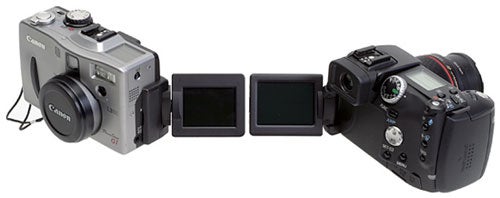
Verdict
Key Specifications
- Review Price: £605.00
In early 2004, the prosumer digital camera market was set alight with the launch of a range of 8 megapixel cameras from the likes of Sony, with its DSC-F828, Nikon and its Coolpix 8700, and Canon with its PowerShot Pro1 that I’ll be taking a closer look at here.
Currently, the Pro1 tops Canon’s PowerShot line-up of digital cameras and unsurprisingly anyone who’s used one of the company’s cameras before will immediately feel at ease with its menu layout and operation. As a user of both the Powershot G1 and EOS 10D I can certainly vouch for that.
However, I have to admit that I have always been a little undecided with the true merits of a prosumer camera. I say that because with the ever tumbling price of digital SLRs, prosumer cameras, in my opinion, are starting to look a little over priced – and that’s before you factor in the generally superior image quality you’ll get from an SLR coupled with a decent lens.
Anyway, I’ll talk more about pricing and image quality later. For now let’s look at what the Pro1 has to offer. As mentioned earlier, the Pro1 features an 8 megapixel CCD sensor which in this case is backed up with what Canon term as iSAPS technology or “intelligent Scene Analysis based on Photographic Space”. This is basically a method of speeding up the AF, AE and Auto White Balance by analysing data that’s derived by relating the brightness of the scene and the distance between the subject and camera according to the zoom position of the lens – all quite techy stuff, but what I can say is that when shooting the same scene in full auto-mode, the Pro1 was far slicker and more precise than my Canon G1.
Of course my Canon G1 is a far older camera, but there are clearly some G-Series features that have been carried through to the design of the Pro1. One of the most obvious that has been retained is the flip out, rotatable LCD screen.

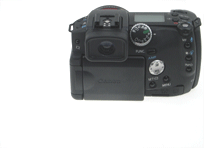
”’Like the G1, the Pro1’s LCD screen can be flipped out, rotated and folded neatly back into the body.”’
I’ve always liked this feature, which makes shooting from the hip or above your head a real possibility. It’s also perfect for self portraits or even group shots when you want to ensure that everyone including yourself is in frame. I also found the Pro1’s 235,000 pixel, two-inch TFT screen clear and bright enough to work with, even on sunny days, providing it’s set to its brightest mode.
Moving on to handling the Pro1 is well-balanced and relatively compact in comparison to most other 8 megapixel cameras on the market. The beefier grip will also make SLR camera users feel at home, while ergonomically, the main controls are positioned around the back of the unit within easy reach of your thumb.
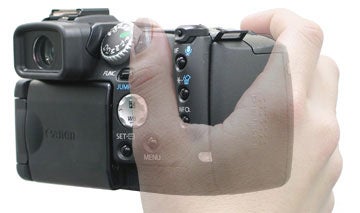
”’The Pro1 is a compact prosumer camera that fits snuggly in the hand thanks to the chunky grip.”’
However, unlike other prosumer digital cameras, zoom control is not operated by a bi-directional lever wrapped around the shutter release button or by separate zoom-in, zoom-out buttons. Instead it’s electronically operated by manually turning the zoom ring. Yes the key word here is electronically. It’s not a mechanical process, and the zoom movement is powered by one of Canon’s ultrasonic motors (USM).
Now this may be a novel approach but in practice electronically controlling the zoom by this means proved to be a little disappointing. It’s just not as responsive as I had hoped, although the zoom speed does vary depending on how fast you turn the zoom ring. That said, on a number of occasions I was able to turn the ring without affect. I also found that zooming was stepped over approximately 40 stages from wide angle to full zoom, so if you’re after truly precise control you might be better off with a digital SLR and an interchangeable zoom lens.
In terms of zoom speed it’s also worth noting that Canon was aware that this might be an issue for some users because it did factor in a method of rapidly zooming the lens. This is done by moving and holding the mode lever (the bi-directional lever mounted on the top right of the Pro1) to the little red camera icon (as you would do to turn the camera on), and then turning the zoom ring. This rapid zooming mode is maintained until the lever is released.
A somewhat awkward workaround in my opinion, but there is another role for the zoom ring that I did like. This comes to light when previewing your images where a quick twist of the zoom ring invokes magnification of the image displayed on the TFT. A press of the magnify button also does the same job with 10 steps up to 10x magnification.
As for the lens itself, this is rated at a reasonably fast f2.8 at full wide angle and f3.5 at full zoom indicating the quality of the optics. However, I did find the maximum aperture of f8 a little limiting especially for studio work where powerful flash heads proved to be too much for the Pro1, even with the ND filter in place. This filter is built-in and can be selected from within the record menu. Its purpose is debatable but it’s intended for muting incidences of overexposure. Personally, I’d prefer the option of selecting a higher aperture setting.
As for the zoom range this is quite impressive covering 7.2mm – 50.8mm which in 35mm SLR language is equivalent to 28 – 200mm. Add to that a 3.2x digital zoom and the numbers becomes pretty remarkable, although the results are somewhat fuzzy. The Pro1’s lens can also focus in on a subject 3cm away in super macro mode, making close-up work a real prospect.
I also cannot let it slip by that Canon has given this lens “L-series” status which before the launch of the Pro1 was a label normally assigned to its high-end range of EOS lenses (as indicated by the red ring). The Pro1’s lens obtains this mark of quality because it features fluorite crystal and Ultra-low Dispersion (UD) glass elements that are designed to reduce chromatic aberration, although I would argue that a compact zoom such as this, with it’s 10-group, 14-element configuration is going to have a hard job minimising this. I’ll comment on image quality shortly, but for now let’s continue with the rest of the Pro1’s features.
In order to begin shooting straightaway, Canon provides you with one of its own BP-511A lithium batteries. This is almost identical to the ones used in many other Canon cameras so if you already own a digital camera from the company the likelihood is that you can use your old battery as a backup. I say almost identical because the capacity has been upped from 1100mAh to 1390mAh which should see it perform well. In fact, Canon quotes that the battery lasts for around 420 shots while using the LCD monitor but in practice the most I got when using the LCD viewfinder was more like 300 including the occasional power down. This is largely subjective though, and will depend heavily on the number of fired flashes, the size of the images and the frequency of zooming etc.
In the box you do get a charger and a neat little infrared remote control that can not only control the shutter release but also the zoom, playback, display, magnifier and thumbnail preview. It takes around 90 minutes for the battery to reach full charge while the remote has a range of around five metres.
Before shooting, you will probably need to calibrate the electronic viewfinder to your viewing eye using the dioptre dial found at the side of the camera – a fiddly affair requiring fingertips with un-bitten nails. However, if you are the sole user this should be a one-off setting. Although I am not a fan of electronic viewfinders myself I found the Pro1’s 235,000 pixel 0.44inch LCD particularly clear and responsive.
Before you can capture images onto the supplied 64MB CompactFlash card – the capacity of which seems a little conservative considering the file sizes generated by the CCD sensor – you first have to slot in the card along with the battery. These fit neatly into their respective slots in a compartment behind a spring-loaded flap that forms the bulk of the Pro1’s beefy grip.
Once loaded you’re pretty much ready to shoot. A quick flick of the mode lever to instigate the shooting mode and you’re off. Of course snapping away can simply be a point and shoot matter using the Pro1’s fully auto mode. This is selected with the mode dial housed at an angle next to the viewfinder. However, the more adventurous can employ some of the Pro1’s other features. For instance, you have a variety of preset modes that are designed for particular shooting conditions such as portraits, landscapes, night scenes as well as a “stitch assist” setting for taking a sequence of shots that can be merged together later on a PC using Canon’s Photostitch software – ideal for making sprawling panoramic images.
Of course there are the usual more advanced settings that you’d expect on a prosumer camera too. There’s focus bracketing, exposure bracketing (+/- 2EV in 1/3 steps), aperture and shutter priority, and of course a self-timer that counts down from 10 seconds or two seconds. In terms of metering you get all you can ask for – evaluative, centre-weighted average or spot metering. There’s even an AF/AE mode termed “FlexiZone” that allows the user to freely scroll the auto focus area around the scene in order to select a focus point.
When selected, most settings are clearly visible on the LCD control panel mounted on the top of the chassis, which in low-light conditions can be lit with an orange backlight. If not present, the majority of settings aswell as a histogram (sadly not live) can be viewed upon successive presses of the info button found on the back of the Pro1.
If you want total control there’s a manual mode too, with access to shutter speeds from 1/4000 to 15 seconds, although rather disappointingly a bulb setting is absent. A manual focus is present too, represented by an on-screen bar, but I doubt many will use this option very often.
For continuous shooting you can opt for 2.5fps or 1fps and for time-lapse photography a function called the “Intervalometer” can be used to capture up to 100 images at intervals between one and 60 minutes.
Another handy feature are the two custom modes that allow you to set up your preferred blend of image resolution, compression level, exposure mode, lens position and other settings, so that every time the Pro1 is turned on you can revert it back to your unique combination. The choice of first curtain or second curtain flash synchronisations together with effects modes vivid, neutral, black and white, sepia, low sharpening (for soft edges), and custom all top off an impressive range of features.
There’s no doubt that the Pro1 is a feature-packed digital camera but sometimes the downfall of possessing this number of settings is organising them within accessible and intuitive menus, something that some manufactures can’t seem to get quite right. Canon however, has pulled it off thanks to clearly displayed menus divided into four main menus – the record, setup, playback and theme menus (the latter being more of a playful setting for personalising the sounds menu pictures).

A four-way control pad on the back of the Pro1 makes scrolling and selecting through these menus simple, whereas the “function” button allows you to select the available settings such as ISO speed (Auto, 50, 100, 200 and 400), file compression/size, and so on. In keeping with tradition as well as functionality, the Pro1 also uses a scroll and click main dial positioned next to the chrome shutter release button. While it lends itself for further setting adjustment and selection, I found that it sat too low in the chassis.

Sticking with the recording options, I found plenty more to keep me happy. I could choose from a standard RGB or Adobe RGB colour space and there’s a choice of three compression rates and five resolutions, plus a RAW mode for loss-less compression and post manipulation. Shooting 15fps AVI movies with audio at three different resolutions is also possible, but as you can see from the tables below storage options on the 64MB card vary greatly depending on the level of compression and of course the file format. It’s obvious that 64MB stands out as being too small for an 8.0 megapixel camera.
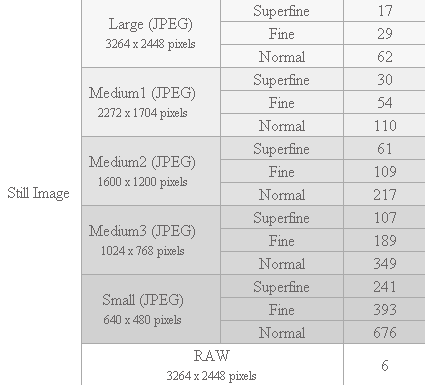

The movies however are clear even when I recently recorded a couple of press events in very low-light conditions. It is a shame however that the powerful zoom cannot be used during recording.
In the box Canon provides most of what you need to get going. An audio/video lead for hooking up to a TV for slide shows and a USB cable for connection to a PC. Unfortunately a power adapter is an optional extra despite the Pro1’s built in DC input.

A good compliment of software is provided including ZoomBrowser EX, Canon’s all-in-one application for uploading, browsing, editing and printing your images. Despite the clean thumbnailed interface, it does take a little time to get used to, while transferring files over the Pro1’s USB1.1 interface can be a painfully slow process. A copy of Photorecord for organising you images and Photostitch for knitting together panoramic vistas complete the bundle.
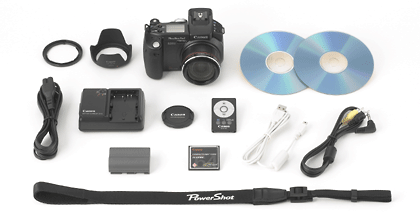
So after a thorough run down of most of the main features I’d say that the PowerShot Pro1 undoubtedly has a lot going for it in terms of settings.
However, the true test of a digital camera lies in its ability to capture light from a scene and reproduce it digitally into an image that looks identical to the original – unless of course you have an artistic streak that dictates otherwise.
”NB. I’ve either had to reduce the image size or produce 400 x 300 pixel 100% crop outs in order for you to get a true idea of the image quality. As of yet we do not have the facility to offer full-res downloads. This facility will be implemented in the next build of the web site”
For evaluating the image quality of the Pro1 I tested the camera in a variety of conditions.
As you can see from some of my general shots the Pro1 is indeed capable of some impressive results. Excellent colour reproduction is evident and skin tones have escaped that pink tinge that seems to plague images produced by lower quality digital cameras.

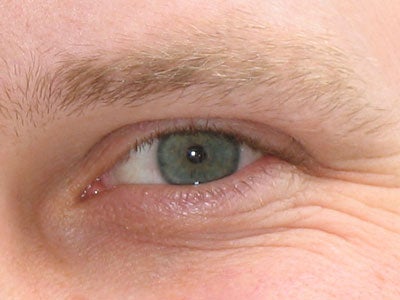
Close-up photography using the super macro setting was indeed also commendable, allowing me to get right up close to the petals and still remain in focus.
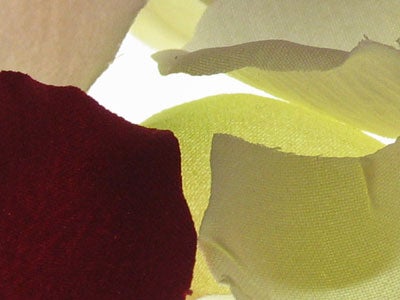
I was very impressed with the zoom range too. The three pictures below give a demonstration of how powerful the zoom is. The top picture is shot at full wide angle (28mm equivalent), the middle shot at maximum optical zoom (200mm equivalent) and the third at 3.2x digital zoom (approx. 640mm equivalent). Granted the shot is grainy at full digital zoom, but some of the detail is retained. I have also seen digital zooms that basically destroy nearly all the detail and in my book this result is rather good. Furthermore, I can just make out some vignetting at the corners of the shot taken at full optical zoom. It would appear that the peripheral edges of the lens barrel are causing light fall-off at these points. The shot was taken at f3.5, the widest aperture for full telephoto, and that’s usually the reason for vignetting. (I repeated the shot at f8 and the vignetting was not noticeable).


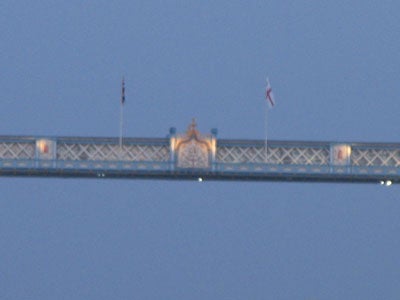
For general use, the Pro1 can capture detail faithfully and noise in areas of high contrast is minimal providing the ISO is kept to 50. Disappointingly noise reared its ugly head in settings as low ISO 100. Higher than that and the noise especially in low light conditions, became apparent. This was a little surprising for me as I’m used to my Canon 10D’s excellent ability to remain almost noise free at ISO 400. The picture below, although shot at night, does exhibit more noise than I’d expect at ISO 100. (aperture f5.6, shutter 1/5sec)

With that in mind and the fact that the PowerShot Pro1 sports an L-series type lens I decided to give the Pro1 one last test, this time pitting it against my Canon 10D complete with its 17-40mm L-series lens.
Now even though both are L-series lenses the two following pictures do show that the Pro1’s lens exhibits some evidence of chromatic aberration around the peripheral edges of the leaf. That said, it’s not too excessive. Interestingly we can also see more noise in the shot taken with the Pro1 even though both pictures were shot at ISO 100. (focal length: 80mm equivalent, shutter 1/125, aperture f5.6)
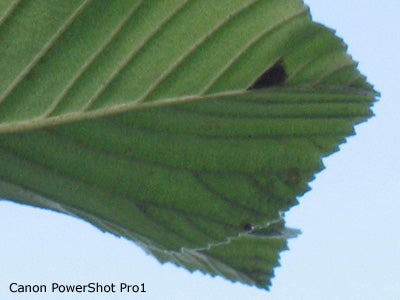

OK so you may think I am a little mad comparing my Canon EOS 10D digital SLR with the prosumer PowerShot Pro1, but there was method in my madness. At the beginning of this review, I mentioned that I remained undecided about the true merits of a prosumer camera largely because the middle ground that they occupy is being encroached upon from both sides of the digital camera market. You just have to take a look around the web to find out how much better compact digital cameras are becoming, and how much cheaper digital SLRs are.
To illustrate what I mean, a while ago Canon released a budget digital SLR, namely the EOS 300D. Now, at the time of writing I have seen this priced at around £600 (without a lens), almost the same price as the Powershot Pro1. Ok so you’ll have to purchase the optics separately, but what you’ll end up with is a camera that on the inside is very similar to my 10D. That and the L-series label explains why I chose to test the Pro1 against my 10D.
So at the end of the day what do you go for? Personally, I’d rather opt for the 300D even though it sports a 6.3 megapixel CMOS sensor. Ok so maybe I won’t be able to enlarge my images as big as those from an 8.0 megapixel prosumer camera, but I can pretty much guarantee that if I did they’d probably look much better.
”’Verdict”’
As it stands the Pro1 is a well made compact digital camera offering plenty of features for both the novice and keen amateur. However, there are some slight niggles concerning ISO sensitivity, chromatic aberrations, and a degree of vignetting. I wasn’t overly keen on the sluggish electronic zoom ring either. That said, leave the Pro1 on ISO 50, and stop down the aperture a little, and it’s likely you’ll get some good results. As a Canon PowerShot G1 user I also liked the Pro1’s familiar operation and of course the flip screen. However, if you’re a keen photographer go for the Canon EOS 300D instead.
(table:features)
Trusted Score
Score in detail
-
Value 6
-
Image Quality 7
Features
| Camera type | Digital Compact |
| Megapixels (Megapixel) | 8 Megapixel |
| Optical Zoom (Times) | 3.2x |

